Now Online: New Disclosure Avoidance System Update Meets or Exceeds Redistricting Accuracy Targets
The U.S. Census Bureau’s most recent updates to the new Disclosure Avoidance System (DAS) fully satisfy the specialized accuracy criteria established for the 2020 Census P.L. 94-171 redistricting data, based on an analysis of the latest set of demonstration data released today.
As described in our April 19 newsletter, this is the fifth such demonstration data set, but the first that reflects a change in the privacy-loss budget (PLB).
The new data utilize a PLB of 10.3 for persons and 1.9 for housing units, totaling a global PLB of 12.2 that more closely approximates the anticipated final PLB to ensure the redistricting use case targets are met.
Previous releases used a constant PLB of 4.0 for persons and 0.5 for housing units (a global PLB of 4.5), which allowed us to compare the effects of incremental algorithmic improvements in the system. Those versions were purposefully “tuned” to privacy and not “tuned” for producing highly accurate redistricting data.
Tuning to Redistricting Accuracy Targets
As we discussed in our April 7 newsletter, the April 2021 Privacy-Protected Microdata Files (PPMFs) was specifically tuned to meet stringent fitness-for-use accuracy targets for the redistricting and Voting Rights Act use cases. This tuning was designed to ensure that the largest racial /ethnic group in “off-spine” geographies (e.g., places or voting districts) with populations of at least 500 people, as a proportion of the total population, was within +/- 5% of the enumerated value at least 95% of the time. The April 2021 PPMFs exceeded this accuracy target. For places and other off-spine entities with populations between 500-549 people, 99.52% of these geographies meet this target; those with larger populations perform even better.
The April 2021 PPMFs incorporated a number of additional improvements that provide better accuracy for many other important statistics.
Some highlights of these improvements include:
County Total Population: All Counties
Mean Absolute Percent Error across all counties is 0.04% (4.91 people) for the April 2021 PPMF. This is down from 0.12% (November 2020), 0.09% (September 2020), 0.14% (May 2020), and 0.78% (October 2019).
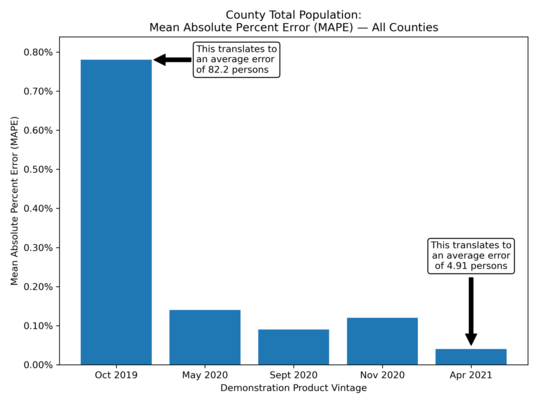
County Total Population: Smallest Counties (Populations Under 1,000)
Mean Absolute Percent Error for the smallest counties (with populations < 1000) is 0.72% (3.74 people). This is down from 6.38% (November 2020), 3.37% (September 2020), 2.72% (May 2020), and 28.49% (October 2019).
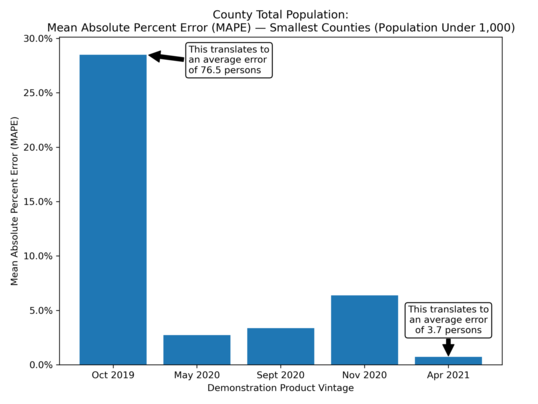
Total Population: All Incorporated Places
Mean Absolute Percent Error across all incorporated places is 1.24% (21 people) for the April 2021 PPMF. This is down from 4.98% (November 2020), 4.24% (September 2020), 8.79% (May 2020), and 10.20% (October 2019).
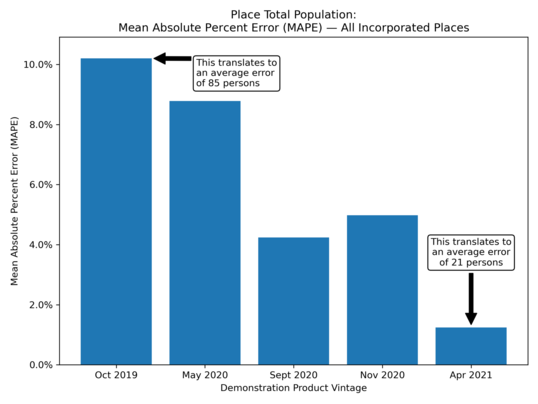
Total Population: Smallest Incorporated Places (Populations Under 500)
Mean Absolute Percent Error for the smallest incorporated places (with populations < 500) is 2.83% (3.6 people) for the April 2021 PPMF. This is down from 12.80% (November 2020), 10.68% (September 2020), 16.62% (May 2020), and 19.03% (October 2019).
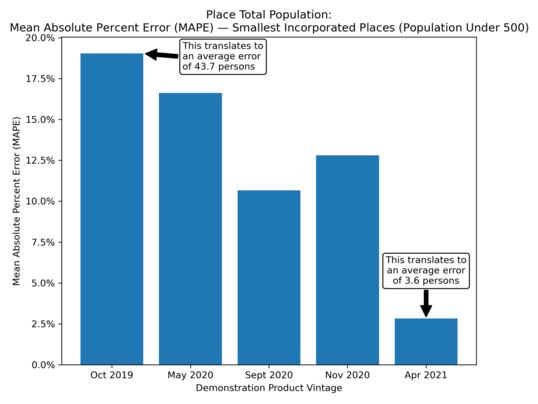
Total Population: Rural Blocks
Mean Absolute Error for rural block-level population counts is 0.91 people for rural blocks in the April 2021 PPMF. This is down from 2.16 people (November 2020), 1.88 people (September 2020), 3.65 people (May 2020), and 3.83 people (October 2019).
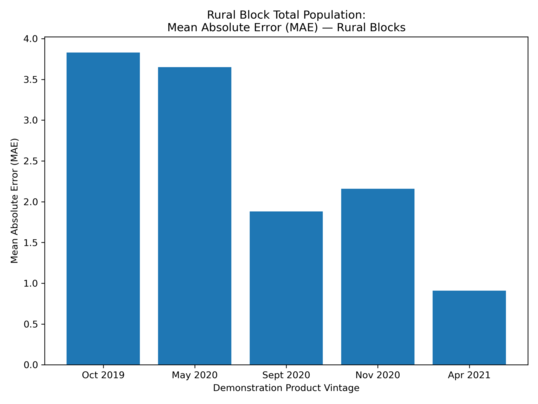
Total Population: Urban Blocks
Mean Absolute Error for urban block-level population counts is 2.52 people in the April 2021 PPMF. This is down from 3.93 people (November 2020), 3.78 people (September 2020), 7.70 people (May 2020), and 9.21 people (October 2019).

Tract Occupancy Rate: All Tracts
Mean Absolute Error in occupancy rates for census tracts is 0.75 percentage points in the April 2021 PPMF. This is down from 1.81 percentage points (November 2020), 1.85 percentage points (September 2020), 1.80 percentage points (May 2020), and 7.23 percentage points (October 2019).
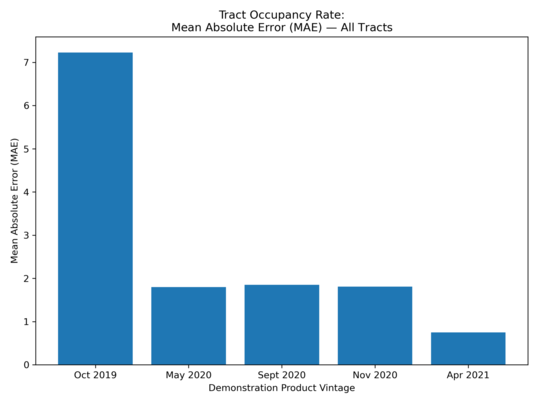
Upcoming Webinar for More Information
To assist with understanding and analyzing the new demonstration data, we will be hosting a webinar on Friday, April 30 at 1:00 p.m. EDT. The webinar will cover in more detail the updates reflected in these files, a walk through of the associated metrics, and an opportunity to ask questions. The webinar is open to the public and a recording will be posted on the website soon after.
Dial-in:
Event: Understanding the April 2021 Demonstration Data
WebEx Event address for attendees:
https://uscensus.webex.com/uscensus/onstage/g.php?MTID=e6f1f895d92d067dbaa0833772487b9ec
WebEx Event number (if needed): 199 529 2379
WebEx Event password (if needed): @Census1
Date and time: Friday, April 30, 2021 1:00 pm EDT
Duration: 1 hour
For Telephone audio option please call
1-800-369-2064 OR 1-212-287-1671
Passcode: 4867486
For 1-way listen only computer audio, please click Audio Broadcast button in WebEx. If it does not connect, please use the telephone audio option.
How to Submit Feedback
The changes in the April 2021 PPMFs data set reflect the cumulative feedback received from the data user community throughout the development process.
We look forward to feedback from data users on this new demonstration product. Your input will inform the Census Bureau’s June 2021 final decision on the PLB and on the 2020 Census redistricting data parameters. The deadline to submit feedback is May 28, 2021.
** Please send comments to 2020DAS@census.gov with the subject line “April 2021 Demonstration Data.” Particularly useful feedback would describe:
-
Fitness-for-use: Based on your analysis, would the data needed for your applications (redistricting, Voting Rights Act analysis, estimates, projections, funding data sets, etc.) be satisfactory?
- How did you come to that conclusion?
- If your analysis found the data to be unsatisfactory, how incrementally would accuracy need to change to improve the use of the data for your required or programmatic use case(s)?
- Have you identified any improbable results in the data that would be helpful for us to understand?"
-
Privacy: Do the proposed products present any confidentiality concerns that we should address in the DAS?
-
Improvements: Are there improvements you’ve identified that you want to make sure we retain in the final design? Be specific about the geography and error metric for the proposed improvement.
2021 Key Dates, Redistricting (P.L. 94-171) Data Product:
TODAY, April 28
- Census Bureau releases new Privacy-Protected Microdata Files (PPMFs) and Detailed Summary Metrics:
- One set with a global privacy-loss budget ("epsilon") of 12.2 (10.3 for persons and 1.9 for housing units), approximating the anticipated final PLB level.
- A second set with the global-privacy loss budget ("epsilon") of 4.5 (4.0 for persons and 0.5 for housing units), as used for prior demonstration data.
May:
- In addition to releasing these new demonstration data for public analysis and evaluation, the Census Bureau also anticipates publishing additional empirical evaluations of the fitness-for-use of these data for redistricting and Voting Rights Act purposes in May.
By May 28:
- Data users submit feedback.
Early June:
- The Census Bureau’s Data Stewardship Executive Policy (DSEP) Committee makes final determination of the PLB, system parameters based on data user feedback for the 2020 Census P.L. 94-171 data.
Late June:
- Final DAS production run and quality control analysis begins for P.L. 94-171 data.
By August 16:
- Release 2020 Census P.L. 94-171 data as Legacy Format Summary File. Released via Census Bureau FTP site.
September:
- Census Bureau releases PPMFs and Detailed Summary Metrics from applying the production version of the DAS to the 2010 Census data.
- Census Bureau releases production code base for P.L. 94-171 redistricting summary data file and related technical papers.
By September 30:
- Release 2020 Census P.L. 94-171 data (released via data.census.gov) and Differential Privacy Handbook.
Was this forwarded to you?
Sign up to receive your own copy!
Useful Links:
Have Suggestions?
Do you have specific questions you'd like us to answer in this newsletter or topics you'd like discussed? Send us an email at 2020DAS@census.gov and let us know!
|